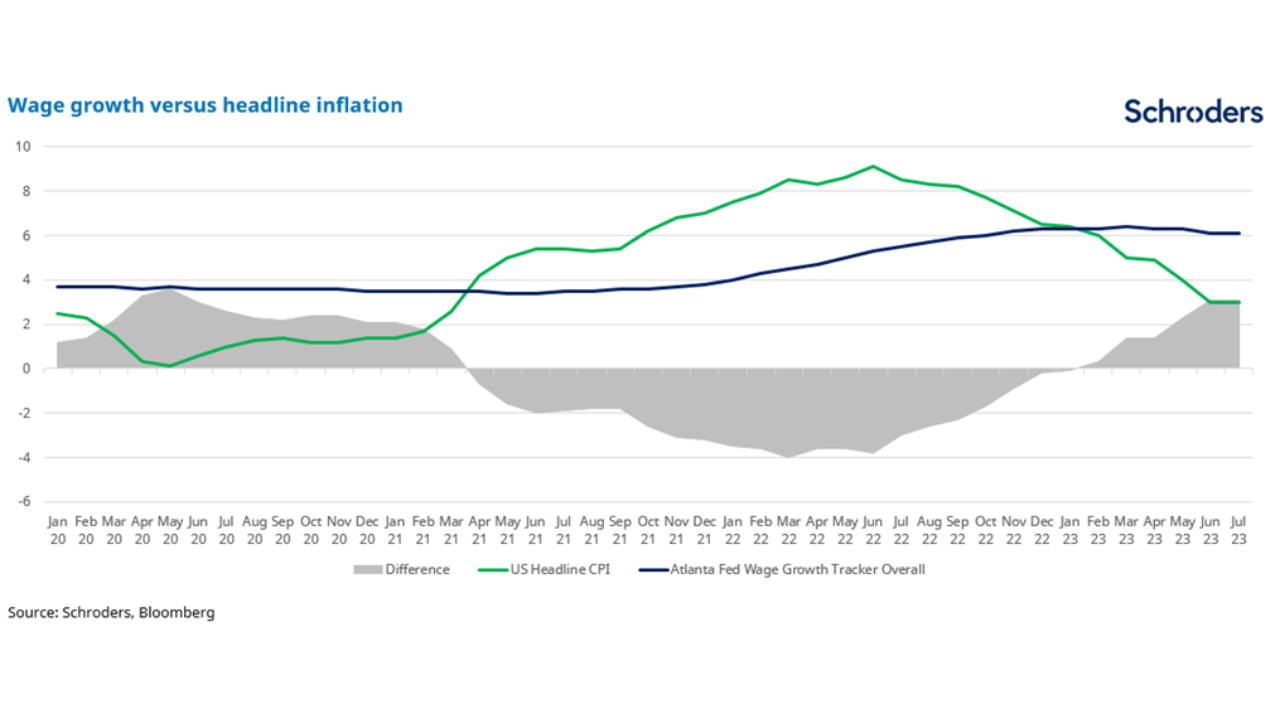Back from the brink
Warren Buffett famously said, “Never bet against America”. The US economy grew 2.4% in the second quarter, topping estimates of 2%. This is despite the Conference Board US Leading Indicators pointing to a deep slowdown and our own models pointing to an imminent recession. No matter where you look, leading indicators continue to deteriorate but hard data remains extremely robust. Senior Loan Officer Surveys point to extremely restrictive lending standards only seen in the depths of the recession.
The Federal Reserve and central banks around the world have undertaken aggressive rate rises unlike any we’ve seen for decades. Manufacturing PMIs continue to contract. Yet despite all this, consumers continue to spend like there is no tomorrow, with corporate profits reaping the benefits by holding up better than expected.
All eyes on the US consumer
We have been surprised by the resilience of the US consumer. Perhaps counter-intuitively, the aggressive rate hike cycle has helped improve real wages in 2023. At the start of the current inflationary period, real wages dipped in 2021 as inflation picked up and wages remained stagnant, but this was offset by still-elevated saving levels, thanks to prior COVID stimulus payments.
However, consumers felt the pinch in 2022 as the war in Ukraine pushed energy prices into uncomfortable territory and the Fed started its aggressive hiking cycle. Even though nominal wages grew strongly, they dipped even deeper in real terms. Today, the Fed’s preferred inflation measure Core PCE still remains uncomfortably high, but headline inflation, which consumers care about, has cratered.
Consumers are benefitting because their wages, while rolling over, are falling slower than headline inflation, leading to a real wage boost, fuelling consumption. Wages will inevitably fall in line with inflation, but for now their capacity to consume has been extended, pushing out the cycle and potential start of a recession.

Part of the conundrum comes from companies hoarding labour. Small businesses employ 48% of the US workforce, but current surveys are dire. The NFIB Small Business Good Time to Expand index remains at lows seen during the aftermath of the GFC or the 1980 recession before that.
These companies are less likely to receive funding from the capital markets and rely on bank loans to operate, but the senior loan officer survey tightening standards for commercial and industrial loans remains very restrictive, at levels seen during the depths of recession.
Normally, this would lead to labour shedding, but given how hard it was to find workers post-COVID, we observe that companies are not willing to let go of them so easily, even if it impacts margins in the short term. This has resulted in collapsing labour productivity, with US Nonfarm Business Sector Output Per Hour Of All Persons falling to -1.6% YoY, the lowest since the 1970s.
There are signs of the labour market cracking, however. The number of job openings and average hourly earnings are declining slowly but surely. ISM manufacturing employment is contracting, temporary workers have been shed, and the number of states with initial claims over 20% year on year are at levels consistent with the start of a recession. However, until companies are willing to lay off staff to protect margins, the consumer remains buoyant.
Pushing out the recession call
We originally saw the regional banking crisis of March 2023 as the canary in the coal mine, reminding the market of how damaging aggressive interest rate hikes can be to the economy and the banking sector. We believed a recession was imminent and positioned our portfolio accordingly.
However, thanks to swift intervention by the Fed, this has been put out of mind for now. Regional banks will have to restrict lending further to pay back emergency loans, but for now this has been liquidity-positive for markets. We are around 18 months into a rate hiking cycle, which is typically when a recession would rear its ugly head, but given how low rates were at the start and how much better household and corporate balance sheets are post-2008, it may take slightly longer this time to play out.
Our recession model is triggered when more than 40% of the signals are confirmed. Our model has dropped from an all-time high of 65% to a still uncomfortably high 50%. However, all of the improvement has come from indicators that lead to a recession by 1-3 months. Those still signalling recession lead to a recession by 6-9 months.
Combined with the real wage growth extension, we have pushed back our recession call to the end of 2023 or the first quarter of 2024. While this means the economy will likely be hotter than we expected, it also means that the market might be wrongfooted on the soft landing scenario and may quickly pivot to price in a higher for longer rate cycle, which could put pressure on US equity multiples and US duration.
Portfolio positioning shifts
As we take a step back from the brink, we have re-risked the portfolio on the margin. To be clear, we are not bullish, but we are no longer positioning for an imminent recession. Instead, our overall positioning has reverted to similar levels held just before the collapse of Silicon Valley Bank. We have increased our delta-adjusted equity positioning from 15% back to 18%. However, under the surface we have increased equities to 20% but hold a 5% put spread to protect the portfolio from any falls from here down to 4,000 on the S&P.
This should allow us to participate in any further rally or blow off top, but move us back to 15% equities quickly if the market falters from here. We have also taken off our 5% short high yield credit protection, 4% last month and the remaining 1% this month. Our credit position remains towards its highs but heavily favouring investment grade credit and Australian subordinated and private debt over global high yield corporates.
We continue to hold elevated levels of duration at around 3 years at the portfolio level, but have been reducing our US duration in favour of Australian duration and moving to shorter dated maturities as central banks near the end of the rate hiking cycle.
We re-risked the portfolio towards the low in September 2022 and believe we captured the ‘safe’ part of the rally, but took chips off the table once valuations were stretched and we entered the more ‘risky’ part of the rally. We continue to hold higher levels of cash as dry powder, earning almost 4.5%, which we look to redeploy into higher-risk assets, if prices correct to compelling valuations or our leading indicators and recession models improve.

Learn more about investing in Schroder Real Return Fund.
2 topics
1 fund mentioned

